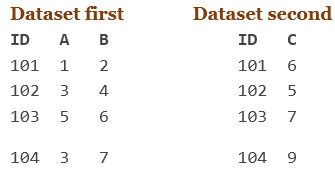
Just as is true for one-to-one reading, if data sets that are being one-to-one merged contain variables that have the same names, the values that are read in from the last data set overwrite the values that were read in from earlier data sets. Note that although this example only combined two data sets, the MERGE statement can contain any number of input data sets.

Since there are seven observations in patients and six observations in scale, the new one2onemerge data set contains seven observations, with missing values for the Height and Weight variables in the seventh observation.

You should see that the first observation in one2onemerge contains the first observation of patients and scale, the second observation in one2onemerge contains the second observation of patients and scale, and so on. Launch and run the SAS program and review the output from the PRINT procedure to see the results of the one-to-one merge. The MERGE statement tells SAS to create a new data set by combining patients and scale. Because the scale data set appears to the right of the patients data set in the SET statement, the variables from the scale data set appear to the right of the variables from the patients data set in the combined one2oneread data set. Note, too, that the position of the variables in the one2oneread data set directly corresponds to the order in which the SET statements appear in the DATA step. Hence, the combined data set, one2oneread, contains six observations, the number of observations in the smallest of the two data sets. You should note, in particular, that SAS does indeed stop reading after reaching the last observation in the scale data set. Launch and run the SAS program, and review the output to convince yourself that the data sets are combined as described. The first SET statement tells SAS first to read the contents of the patients data set into the program data vector, and then the second SET statement tells SAS to read the contents of the scale data set into the program data vector. The meat of the one-to-one read takes place in the third (and last) DATA step, in which we see two SET statements. Of course, the first two DATA steps just read in the respective patients and scale data sets.

#SAS COMBINE DATASETS CODE#
write SAS code to interleave two or more SAS data sets.understand how SAS handles concatenating data sets when variables have different lengths across the input data sets.

understand how SAS handles concatenating data sets when formats, informats, or labels differ across the input data sets.understand how SAS handles concatenating data sets when variable types differ across the input data sets.predict the size of the output data set when concatenating two or more SAS data sets.write SAS code to concatenate two or more SAS data sets.predict the size of the output data set when one-to-one merging two or more SAS data sets.write SAS code to one-to-one merge two or more SAS data sets.predict the size of the output data set when one-to-one reading two or more SAS data sets.write SAS code to one-to-one read two or more SAS data sets.Upon completing this lesson, you should be able to do the following: Upon completion of this lesson, you should be able to:


 0 kommentar(er)
0 kommentar(er)
